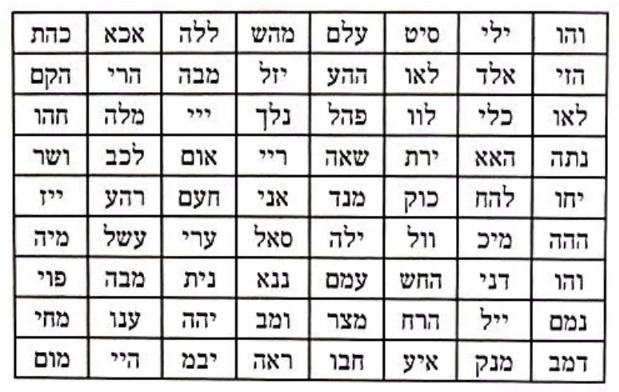
72 ‘Names’ of G-d
Many approaches to prayer and meditation use the 72 ‘Names’ of G-d so that their powers, which are within them, can be released from within us. Strength, joy, peace of mind, good health, and good feelings all come from within. Every sound has a unique vibration and affects the human nervous system, especially the hormones and the spinal cord that holds the body structure together.
More information from Moshe Yaakov Wisnefsky
https://www.chabad.org/kabbalah/article_cdo/aid/1388270/jewish/72-Names-of-G-d.htm
The three consecutive verses from Exodus 14:19-21 each contain 72 letters, an obviously rare phenomenon. The letters of these three verses can be arranged as 72 triplets of letters. But we are taught in Kabbalah that if we reverse the order of the letters in the middle set, the 72 triplets become 72 “names” of G-d.
In Hebrew, these three verses each contain 72 letters. In the Zohar (II:51b) it is stated that these three verses refer in sequence to the divine attributes of chesed, gevura, and tiferet. The harmonious blending of these three principle emotive attributes forms the basic paradigm of how G-d relates to the world. Thus, they together form a composite name of G-d, since a name is a means by which one is made known to others, i.e. manifests his attributes.
The fact that each verse contains 72 letters means that they can be aligned in parallel, forming 72 triplets of letters. In this configuration, the Zohar states, the first verse is to be written in its proper order, since it represents G-d’s loving-kindness, or a direct revelation of G-d’s goodness.
The second verse is to be written in reverse order, from the last letter to the first, since it represents G-d’s severity, which is an indirect revelation of His goodness. Although tiferet is a blend of both chesed and gevura, the third verse is not to be written half in the proper order and half in reverse order, as one might expect.
There are two reasons for this: (1) in tiferet, chesed dominates over gevura, and (2) as the ideal blend of chesed and gevura, tiferet is a direct revelation of G-d’s goodness and glory rather than an indirect one.
(This array may be seen inter alia in the standard editions of the Zohar, volume 2, p. 270a.)
Moshe Yaakov Wisnefsky is a scholar, writer, editor, and anthologist, living in Jerusalem. He has recently produced two monumental works: “Apples from the Orchard: Arizal on the Weekly Torah” and a Chumash translation with commentary based on the works of the Lubavitcher Rebbe (Kehot).

